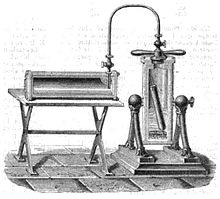Adrien Thilorier
Adrien Jean Pierre Thilorier (born February 16, 1790 in Paris , † December 2, 1844 ) was a French inventor and chemist. He is considered to be the inventor of dry ice (production of solid carbon dioxide).
He was the son of the lawyer Jean Charles Thilorier (1756-1818), known as the lawyer of Alessandro Cagliostro in the collar affair , but who was also known as an inventor and as the author of popular science books such as Système universel (4 volumes, Paris 1815). Little is known about the life of Adrien Thilorier. His first invention was a hydrostatic lamp for lighthouses (a liquid displaced the oil in the container and thus ensured that the lamp burned steadily). However, this was in competition with similar inventions of the time and Thilorier called the academy in Paris over priority disputes. In 1829 he won the Academy's Montyon Prize with a device for compressing gases. In 1834 he demonstrated the liquefaction of carbon dioxide with one of his compressors and in 1835 he described the production of solid carbon dioxide in a note for the academy. The snow-like substance was created when liquid carbon dioxide was poured into a glass bottle and the discovery quickly spread beyond France. A mixture of dry ice with ether was known as Thilorier's mixture and was used for cooling in experiments.
In 1832 he again won the academy's Montyon Prize for a mercury vacuum pump. In the same year he is mentioned as an employee of the French post office.
Its compressors developed up to 1000 atmospheres pressure. His name became notoriously known when, in a lecture by Antoine Bussy at the École d'Pharmacie in December 1840, one of the compressors built according to his model exploded (it was made of cast iron instead of wrought iron). The taxidermist Osmin Hervy lost a leg and died a little later. Thilorier envisaged a wide variety of applications for his compressor, including as a drive for vehicles and submarines, for divers, mineral water production and hydraulic presses.
Since he almost always signed his publications with Thilorier, there was a mix-up in literature, first in the biography of Louis Thénard by his son Paul Thénard , who mistook him for a student at the École Polytechnique named Charles-Saint-Ange Thilorier. This was borrowed from a 1952 article by Duane Roller on the invention of dry ice.
In 1968, the Balzac researcher Madeleine Ambrière-Fargeaud published a study on the "mad scientist" Balthazar Claës in Balzac's story La Recherche de l'absolu and identified the inventor Adrien Thilorier as one of his role models. In 2003 the Dutch science historian Joost Mertens confirmed the identification. In particular, Thilorier's patents identified him as Adrien Thilorier.
literature
- Joost Mertens, You côté d'un chimiste nommé Thilorier. Balthazar Claës modèle d'Adrien Thilorier , L'Année balzacienne, 1, 2003, no.4
Individual evidence
- ↑ Thilorier, Solidification de l'acide carbonic, Comptes rendus Acad. Sci., 1, 1835, pp. 194-196. Digitized
- ↑ scooters, Thilorier and the first solidification of a "permanent" gas (1835), "Isis, Volume 43, 1952, pp 109-113
- ↑ Ambrière-Fargeaud: Balzac et "La Recherche de l'absolu", Hachette, 1968, 2nd edition, PUF, 1999, pp. 91-107
´
| personal data | |
|---|---|
| SURNAME | Thilorier, Adrien |
| ALTERNATIVE NAMES | Thilorier, Adrien Jean Pierre (full name) |
| BRIEF DESCRIPTION | French inventor and chemist |
| DATE OF BIRTH | February 16, 1790 |
| PLACE OF BIRTH | Paris |
| DATE OF DEATH | December 2, 1844 |
